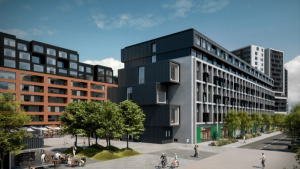
In the fourth quarter of 2024, Warsaw’s office market continued to experience stable occupier demand amid constrained new supply, with tenants seeking to secure spaces in the city centre and expecting sustainable solutions, reveals the latest report from BNP Paribas Real Estate Poland.
New office supply remains low in 2024
In the fourth quarter of 2024, only 11,000 sqm of office space came on stream in Warsaw through a single project: The Form in the City Centre West. This brought 2024’s total new office supply to just over 104,000 sqm, the second-lowest annual figure since records began.
“Between January and December 2024, the highest level of new office deliveries was recorded in central Warsaw, with over 86,000 sqm completed, accounting for nearly 83% of last year’s total. This trend looks set to carry on in 2025, with approximately 90% of the development pipeline scheduled for completion by the end of this year located in the city centre”, says Małgorzata Fibakiewicz, Senior Director, Office Agency, BNP Paribas Real Estate Poland.
It is also notable that while the scarcity of prime land in central Warsaw is likely to stall development activity in this part of the city, developers will require pre-lets before launching new projects in non-central locations.
Is there a need for larger spaces?
Total gross take-up for the fourth quarter reached 244,000 sqm, marking a 35% increase compared with the third quarter but a 4% decline year-on-year. Central Warsaw remained the top location for tenants, accounting for over 54% of all office leases.
Demand continued to outstrip new supply, pushing the overall vacancy rate slightly lower in the final quarter. At the end of the fourth quarter of 2024, Warsaw’s vacancy rate stood at 10.6%, marking a slight decrease from the previous quarter. The city centre recorded a lower vacancy rate of 8.8%, while non-central locations reported 12% of their stock as unoccupied.
BNP Paribas Real Estate Poland notes that although office availability totalled 664,000 sqm at the end of last year, vacant office space was dispersed across the city and frequently divided into smaller units. Tenants seeking large, open-plan spaces are likely to face challenges in finding the right building. At the end of the fourth quarter, only five office buildings in Warsaw had vacant offices exceeding 10,000 sqm.
Green office buildings and new market challenges
Tenants are increasingly seeking ESG-compliant offices, which is also impacting developers’ strategies.
“The real estate sector has a huge impact on the natural environment, as the built environment accounts for approximately 40% of worldwide energy consumption and 30% of greenhouse gas emissions. As a result, sustainability in real estate has become a priority not only for developers and investors but also for tenants who expect office landlords to minimise environmental impact”, comments Dorota Mielke, Associate Director, Office Agency, BNP Paribas Real Estate Poland.
With growing demand for green certifications such as BREEAM and LEED, the adoption of energy-efficient technologies looks set to be a key factor in the future of the office market. Looking ahead, the evolving legal landscape and a focus on social and environmental responsibility will undoubtedly continue to shape the market. Another important factor at play is rapidly changing work environments.
“Clients are growing more focused on analysing the design-cost trade-off, expecting holistic solutions that account for trends such as space revitalisation and optimisation while providing enhanced functionality. With office design becoming more complex, responsible planning is essential in mitigating risks and, particularly, variability under long-term leases”, says Jan Pawlik, Workplace Management Director, ISS.



